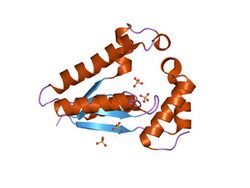Biology:Zeta toxin protein domain
| Zeta_toxin | |||||||||
|---|---|---|---|---|---|---|---|---|---|
 structure and mechanism of t4 polynucleotide kinase | |||||||||
| Identifiers | |||||||||
| Symbol | Zeta_toxin | ||||||||
| Pfam | PF06414 | ||||||||
| Pfam clan | CL0023 | ||||||||
| InterPro | IPR010488 | ||||||||
| SCOP2 | 1gvn / SCOPe / SUPFAM | ||||||||
| Membranome | 314 | ||||||||
| |||||||||
In molecular biology, the protein domain Zeta (ζ) toxin refers to a protein domain found in prokaryotes, which acts as a UDP-N-acetylglucosamine kinase.[1] Its function is to inhibit cell wall biosynthesis and it may act as a bactericide in nature. It is also thought that Zeta toxin induces reversible protective dormancy and permeation to propidium iodide (PI).[2]
Mechanism
This protein family entry consists of several bacterial zeta toxin proteins. Zeta toxin is thought to be part of a postsegregational killing (PSK) system involved in the killing of plasmid-free cells. It relies on antitoxin/toxin systems that secure stable inheritance of low and medium copy number plasmids during cell division and kill cells that have lost the plasmid.[3]
Structure
The Zeta Toxin is folded like a phosphotransferase. This domain features an α/β structure and the central twisted β-sheet contains six β-strands. The first 5 strands are parallel but β-strand 6 is antiparallel and connected by a short loop to β-strand 5. α-Helices are inserted between and flank the β-strands.[3]
References
- ↑ Mutschler, H., Gebhardt, M., Shoeman, R.L. and Meinhart, A. (2011). "A novel mechanism of programmed cell death in bacteria by toxin-antitoxin systems corrupts peptidoglycan synthesis". PLOS Biol 9 (3): #e1001033–e1001033. doi:10.1371/journal.pbio.1001033. PMID 21445328.
- ↑ "The ζ toxin induces a set of protective responses and dormancy.". PLOS ONE 7 (1): e30282. 2012. doi:10.1371/journal.pone.0030282. PMID 22295078. Bibcode: 2012PLoSO...730282L.
- ↑ 3.0 3.1 "Crystal structure of the plasmid maintenance system epsilon/zeta: functional mechanism of toxin zeta and inactivation by epsilon 2 zeta 2 complex formation". Proc. Natl. Acad. Sci. U.S.A. 100 (4): 1661–6. February 2003. doi:10.1073/pnas.0434325100. PMID 12571357.
 |

